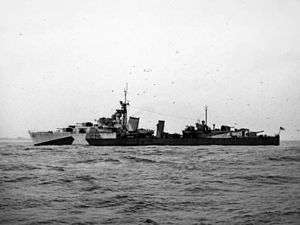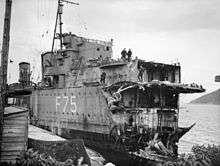HMS Eskimo (F75)
HMS Eskimo was a Tribal-class destroyer, Eskimo served throughout the Second World War, seeing action in Norway, the Mediterranean, the English Channel and in Burma. After the war Eskimo was used as an accommodation and headquarters ship, finally being used as a practice target before being scrapped in 1949.
 Eskimo in April 1944 | |
| History | |
|---|---|
| Name: | Eskimo |
| Namesake: | Eskimo |
| Ordered: | 19 June 1936 |
| Builder: | Vickers-Armstrongs, Walker, Newcastle upon Tyne |
| Cost: | £342,108 |
| Laid down: | 5 August 1936 |
| Launched: | 3 September 1937 |
| Completed: | 30 December 1938 |
| Identification: | Pennant number: L75, F75 & G75 successively |
| Fate: | Sold for scrap, 27 June 1949 |
| General characteristics (as built) | |
| Class and type: | Tribal-class destroyer |
| Displacement: |
|
| Length: | 377 ft (115 m) (o/a) |
| Beam: | 36 ft 6 in (11.13 m) |
| Draught: | 11 ft 3 in (3.43 m) |
| Installed power: |
|
| Propulsion: | 2 × shafts; 2 × geared steam turbines |
| Speed: | 36 knots (67 km/h; 41 mph) |
| Range: | 5,700 nmi (10,600 km; 6,600 mi) at 15 knots (28 km/h; 17 mph) |
| Complement: | 190 |
| Sensors and processing systems: | ASDIC |
| Armament: |
|
Description
The Tribals were intended to counter the large destroyers being built abroad and to lend gun support to the existing destroyer flotillas and were thus significantly larger and more heavily armed than the preceding I class.[1] The ships displaced 1,891 long tons (1,921 t) at standard load and 2,519 long tons (2,559 t) at deep load.[2] They had an overall length of 377 feet (114.9 m), a beam of 36 feet 6 inches (11.1 m)[3] and a draught of 11 feet 3 inches (3.4 m).[4] The destroyers were powered by two Parsons geared steam turbines, each driving one propeller shaft, using steam provided by three Admiralty three-drum boilers. The turbines developed a total of 44,000 shaft horsepower (33,000 kW) and gave a maximum speed of 36 knots (67 km/h; 41 mph).[3] The ships carried enough fuel oil to give them a range of 5,700 nautical miles (10,600 km; 6,600 mi) at 15 knots (28 km/h; 17 mph).[4] The ships' complement consisted of 190 officers and ratings, although the flotilla leaders carried an extra 20 officers and men for the Captain (D) and his staff.[5]
The primary armament of the Tribal-class destroyers was eight quick-firing (QF) 4.7-inch (120 mm) Mark XII guns in four twin-gun mounts, designated 'A', 'B', 'X', and 'Y' from front to rear. For anti-aircraft (AA) defence, they carried a single quadruple mount for the 40-millimetre (1.6 in) QF two-pounder Mk II "pom-pom" AA gun and two quadruple mounts for the 0.5-inch (12.7 mm) Mark III machine gun.[6] The ships were fitted with a single above-water quadruple mount for 21-inch (533 mm) torpedoes.[5] The Tribals were not intended as anti-submarine ships, but they were provided with ASDIC, one depth charge rack and two throwers for self-defence, although the throwers were not mounted in all ships;[7] Twenty depth charges were the peacetime allotment, but this increased to 30 during wartime.[8]
Wartime modifications
Heavy losses to German air attack during the Norwegian Campaign demonstrated the ineffectiveness of the Tribals' anti-aircraft suite and the RN decided in May 1940 to replace 'X' mount with two QF 4-inch (102 mm) Mark XVI dual-purpose guns in a twin-gun mount. To better control the guns, the existing rangefinder/director was modified to accept a Type 285 gunnery radar as they became available. The number of depth charges was increased to 46 early in the war, and still more were added later.[9] To increase the firing arcs of the AA guns, the rear funnel was shortened and the mainmast was reduced to a short pole mast.[10]
Construction and career
Eskimo was laid down by the High Walker Yard of Vickers-Armstrong at Newcastle-on-Tyne on 5 August 1936. She was launched on 3 September 1937[11] and commissioned on 30 December 1938.

Eskimo participated in the Second Battle of Narvik in April 1940.[12] On 12 April, Eskimo was hit by a torpedo fired from German destroyer Z2 Georg Thiele. The explosion caused severe damage, blowing off Eskimo's bow.[13] After temporary repairs by the shipwrights of the fleet repair ship Vindictive at Skjelfjorden in Norway,[14] Eskimo was able to return to the Vickers-Armstrong works at Newcastle for rebuilding.[15]
She supported the Allied landings in North Africa in November 1942 and served with the 10th Destroyer Flotilla at Plymouth. Eskimo was extensively damaged when two German dive bombers attacked her in the Mediterranean while taking part in Operation Husky.[15] She cornered and sank the enemy German submarine U-971 while in company with the Canadian destroyer Haida and a Liberator aircraft of the Czech air force in the English Channel north of Brest on 24 June 1944.[16] During the final days of the war, she operated in the Far East.
Fate
Eskimo was reduced to an accommodation and headquarters ship for minesweepers, wreck-disposal vessels, and salvage craft clearing the Thames and Medway estuaries in 1946. She was used as a target ship in the Gareloch, sold for scrap on 27 June 1949 and finally broken up at Troon.
Museum holdings
Eskimo's bell is in the collection of the National Maritime Museum.[17] Imperial War Museums holds a range of material relating to Eskimo, including photographs, film,[18] and an officially commissioned watercolour by Vivian Pitchforth showing Eskimo refitting at Durban.[19] The National Museum of the Royal Navy holds a detailed ship model of Eskimo, built by Commander John West.[20] West had served in Eskimo as navigating officer at Narvik.[21]
Her Pennant and Crest are on display at St Clares Church in Newton Aycliffe, Co Durham
Notes
- Lenton, p. 164
- English, p. 14
- Lenton, p. 165
- English, p. 12
- Whitley, p. 99
- Hodges, pp. 13–25
- Hodges, pp. 30–31, 40
- English, p. 15
- Friedman, p. 34; Hodges, pp. 41–42
- Whitley, p. 116
- The Times (London), Saturday, 4 September 1937, p.12
- The Times (London), Friday, 26 April 1940, p.6
- Williamson, Gordon (2012). German Destroyers 1939-1945. Osprey Publishing. pp. 35–36. ISBN 9781780966212. Retrieved 29 September 2013.
- Sims, George (1972). H.M.S. Coventry, anti-aircraft cruiser. H.M.S. Coventry Old Hands. Retrieved 29 September 2013.
- Guðmundur Helgason. "HMS Eskimo (F 75)". Uboat.net. Retrieved 29 September 2013.
- Gough, Barry M; Wood, James A (Summer 2001). "'One more for luck': The destruction of U971 by HMCS Haida and HMS Eskimo, 24 June 1944" (PDF). Canadian Military History. 10 (3): 7–22. Archived from the original (PDF) on 2 October 2013. Retrieved 29 September 2013.
- "Ship's Bell [HMS Eskimo]". collections.rmg.co.uk. Royal Museums Greenwich. Retrieved 29 September 2013.
- "Collections Search for 'HMS Eskimo'". iwm.org.uk. Imperial War Museums. Retrieved 29 September 2013.
- "HMS Eskimo and other Destroyers Fitting Out at Durban". iwm.org.uk. Imperial War Museums. Retrieved 29 September 2013.
- Brady, Mark (Autumn 2012). John Roberts (ed.). "The museum's models: HMS Eskimo (1938)" (PDF). Scuttlebutt: The magazine of the National Museum of the Royal Navy (Portsmouth), HMS Victory and the Friends. National Museum of the Royal Navy (45): 24–27. Archived from the original (PDF) on 22 March 2013. Retrieved 29 September 2013.
- "Commander John West [obituary]". telegraph.co.uk. 20 November 2002. Retrieved 29 September 2013.
References
| Wikimedia Commons has media related to HMS Eskimo (F75). |
- Brice, Martin H. (1971). The Tribals. London: Ian Allan. ISBN 0-7110-0245-2.
- Crabb, Brian James (1998). In Harm's Way. The Story of HMS Kenya. A Second World War Cruiser. England: Paul Watkins. ISBN 1-900289-02-4.
- Crabb, Brian James (2014). Operation Pedestal. The Story of Convoy WS21S in August 1942. England: Shaun Tyas. ISBN 978-1-907730-19-1.
- English, John (2001). Afridi to Nizam: British Fleet Destroyers 1937–43. Gravesend, Kent: World Ship Society. ISBN 0-905617-64-9.
- Friedman, Norman (2006). British Destroyers and Frigates, the Second World War and After. Annapolis, Maryland: Naval Institute Press. ISBN 1-86176-137-6.
- Haarr, Geirr H. (2010). The Battle for Norway: April–June 1940. Annapolis, Maryland: Naval Institute Press. ISBN 978-1-59114-051-1.
- Haarr, Geirr H. (2009). The German Invasion of Norway, April 1940. Annapolis, Maryland: Naval Institute Press. ISBN 978-1-59114-310-9.
- Hodges, Peter (1971). Tribal Class Destroyers. London: Almark. ISBN 0-85524-047-4.
- Lenton, H. T. (1998). British & Empire Warships of the Second World War. Annapolis, Maryland: Naval Institute Press. ISBN 1-55750-048-7.
- Rohwer, Jürgen (2005). Chronology of the War at Sea 1939–1945: The Naval History of World War Two (Third Revised ed.). Annapolis, Maryland: Naval Institute Press. ISBN 1-59114-119-2.
- Whitley, M. J. (1988). Destroyers of World War Two: An International Encyclopedia. Annapolis, Maryland: Naval Institute Press. ISBN 0-87021-326-1.